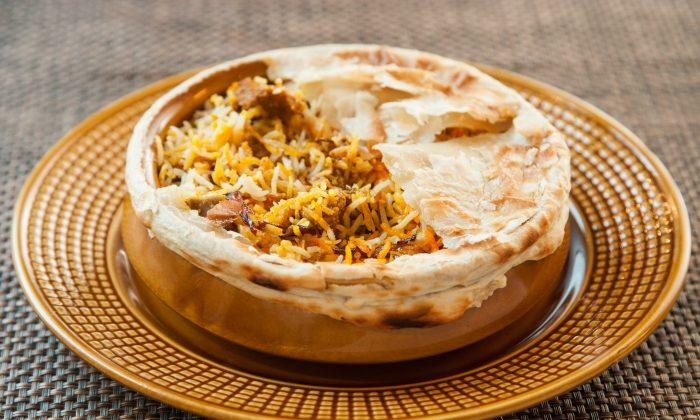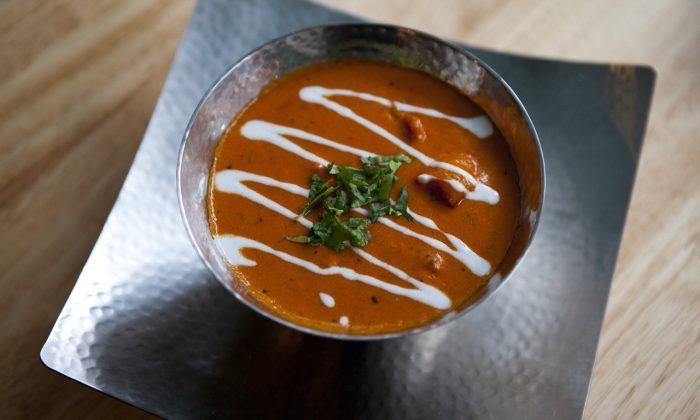JAKARTA, Indonesia—Emma Holiza’s love for painting and her mother’s appreciation for Javanese culture led her to painting with wax on cloth, the fabulous craft honed to perfection in Indonesia—batik.
Indonesia’s greatest contribution to world culture, this craft originated from the royal Javanese court, primarily from the ancient kingdom of Mataram. From the palace, batik spread to coastal areas.
On many trade routes, Java accepted other religions and cultures. The Chinese, East Indians, Arabs, Dutch, and British each left their mark on Javanese culture and the making of batik.
Batik artisans can be found in Mexico, India, Malaysia, and Africa, but the finest work is found in Indonesia—delicate, detailed patterns, meticulously designed. As early as the 1300s, batik craftsmen honed their skills. Each design of Indonesian batik tells a story, conveying a powerful sense of place and of people.
On my last visit to Jakarta, I discovered Emma Holiza’s shop—Omah Batik Nebu Sauyun—very possibly one of the few remaining bastions of fine batik.
Holiza’s mission is to preserve and protect this beautiful and unique Indonesian tradition. She told me her shop continuously improves on traditional techniques and motifs and their designs preserve the original charm and identity of batik while giving a modern look. The fabrics appeal to all ages for celebrations and ceremonies, from casual to business to formal.
Certain areas specialize in certain designs. Designs from Central Java blossom with traditional patterns in brown, black, and yellow. Java’s northern coast near Pekalongan and Cirebon find inspiration in Chinese culture and use bright reds and blues and more intricate flower and cloud designs.
Kawung, a Javanese design from the 13th century, plays with a circle motif. This design can be found in the royal court of Sultan Jogjakarta and in Prambanan near Jogjakarta and Kediri in East Java, as well as engraved on temple walls. The design sometimes carries ovals within the circles. Intersecting lines or dots with the ovals represent fruit of the kapok, or silk cotton tree, or the aren, sugar palm.
Both the dark areas and the light areas in batik create interest. The motifs are related, and the reality of one motif is dependent on the presence of the other. One way to look at the classic Kawung pattern, for instance, is to place the diamond at the center, surrounded by ovals, with clusters of circles at the four tips.
Another interpretation has a small circle in the center with ovals radiating out. Diamond shapes fit into the space between the outer ends of the petals and form a border for the pattern. The eye singles out first one and then the other approach in a way that is neither jarring nor dismissive of either interpretation, an example of inner peace and balance.
Central Java’s royal court favors an exclusive design called Parang—literally, “rugged rock,” “broken blade,” or “knife pattern.” With at least 40 variations of this design, the most famous and elegant is the Parang Rusak. Consisting of rows of folded Parang, the design consists of sweeping lines with slanting rows of blade-shaped bands.
The bands run parallel with alternating narrower bands of a darker and contrasting color. The Parang often embellishes ornaments and musical instruments, such as the Javanese musical ensemble of xylophones, bamboo flutes, drums, and gongs known as the gamelan.
Although Java is acknowledged as producing the finest batik, 19 of Indonesia’s other 33 provinces, from Aceh to Papua, have developed designs unique to their local culture.
The weaving motifs and intricate designs are not just for aesthetics, but also to raise awareness of one’s surroundings, a guide on how to conduct oneself throughout life. A child is first received on folded batik and swathed in batik as a baby. A batik shoulder sling carries baby until he is able to walk.
In small cities and villages, people carry large or heavy bundles with batiks slung over one arm and tied. Wealthy Indonesians favor high-fashion designs drawn on silk. These exceptionally high-quality pieces can take months to create and costs hundreds of dollars.
Holiza said batik was initially created on cotton or silk but now synthetic fabrics are used. She still applies the traditional process passed down for hundreds of years. Batik uses canting, a tool that applies the wax dots of color to fabric.
Because most batik is done is small workshops, it might take almost a year to make one piece. Holiza said it takes three to four months to make the pattern on cloth. Antique batik is sought after because the ladies chant a mantra for good health and fortune as they apply wax to fabric.
“In Indonesia, we say that every batik tells a story,” said Holiza. Designs for good fortune abound. Certain designs are made for brides and grooms, others for royalty, each design determining the rank and occasion.
The process of making the royal batik Pedalaman differs from the coastal Persisiran.
Pedalaman designs use browns known as Soga and dark blues and whites on a beige background. Soga is made from the bark of Tenggi, Jmbal, and Tegeran woods. The blue and beige pigments come from indigo or tom leaves.
Persisiran produces more colorful batik and are favored by Dutch, Chinese, and Indonesian batik designers. The Persisiran process was used more as synthetic color became popular. The city of Pekalongan as well as the batik centers of Java’s northern coast also use this process.
Two prominent ladies have shown a similar fascination and appreciation for batik, President Obama’s late mother, Ann Dunham, and Madame Ani Bambang Yudhoyono, the First Lady of Indonesia. Madame Yudhoyono’s collections will be exhibited at the New York Indonesian Consulate, 5 East 68 Street on July 24, 2009.
Indonesia’s greatest contribution to world culture, this craft originated from the royal Javanese court, primarily from the ancient kingdom of Mataram. From the palace, batik spread to coastal areas.
On many trade routes, Java accepted other religions and cultures. The Chinese, East Indians, Arabs, Dutch, and British each left their mark on Javanese culture and the making of batik.
Batik artisans can be found in Mexico, India, Malaysia, and Africa, but the finest work is found in Indonesia—delicate, detailed patterns, meticulously designed. As early as the 1300s, batik craftsmen honed their skills. Each design of Indonesian batik tells a story, conveying a powerful sense of place and of people.
On my last visit to Jakarta, I discovered Emma Holiza’s shop—Omah Batik Nebu Sauyun—very possibly one of the few remaining bastions of fine batik.
Holiza’s mission is to preserve and protect this beautiful and unique Indonesian tradition. She told me her shop continuously improves on traditional techniques and motifs and their designs preserve the original charm and identity of batik while giving a modern look. The fabrics appeal to all ages for celebrations and ceremonies, from casual to business to formal.
Certain areas specialize in certain designs. Designs from Central Java blossom with traditional patterns in brown, black, and yellow. Java’s northern coast near Pekalongan and Cirebon find inspiration in Chinese culture and use bright reds and blues and more intricate flower and cloud designs.
Kawung, a Javanese design from the 13th century, plays with a circle motif. This design can be found in the royal court of Sultan Jogjakarta and in Prambanan near Jogjakarta and Kediri in East Java, as well as engraved on temple walls. The design sometimes carries ovals within the circles. Intersecting lines or dots with the ovals represent fruit of the kapok, or silk cotton tree, or the aren, sugar palm.
Both the dark areas and the light areas in batik create interest. The motifs are related, and the reality of one motif is dependent on the presence of the other. One way to look at the classic Kawung pattern, for instance, is to place the diamond at the center, surrounded by ovals, with clusters of circles at the four tips.
Another interpretation has a small circle in the center with ovals radiating out. Diamond shapes fit into the space between the outer ends of the petals and form a border for the pattern. The eye singles out first one and then the other approach in a way that is neither jarring nor dismissive of either interpretation, an example of inner peace and balance.
Central Java’s royal court favors an exclusive design called Parang—literally, “rugged rock,” “broken blade,” or “knife pattern.” With at least 40 variations of this design, the most famous and elegant is the Parang Rusak. Consisting of rows of folded Parang, the design consists of sweeping lines with slanting rows of blade-shaped bands.
The bands run parallel with alternating narrower bands of a darker and contrasting color. The Parang often embellishes ornaments and musical instruments, such as the Javanese musical ensemble of xylophones, bamboo flutes, drums, and gongs known as the gamelan.
Although Java is acknowledged as producing the finest batik, 19 of Indonesia’s other 33 provinces, from Aceh to Papua, have developed designs unique to their local culture.
The weaving motifs and intricate designs are not just for aesthetics, but also to raise awareness of one’s surroundings, a guide on how to conduct oneself throughout life. A child is first received on folded batik and swathed in batik as a baby. A batik shoulder sling carries baby until he is able to walk.
In small cities and villages, people carry large or heavy bundles with batiks slung over one arm and tied. Wealthy Indonesians favor high-fashion designs drawn on silk. These exceptionally high-quality pieces can take months to create and costs hundreds of dollars.
Holiza said batik was initially created on cotton or silk but now synthetic fabrics are used. She still applies the traditional process passed down for hundreds of years. Batik uses canting, a tool that applies the wax dots of color to fabric.
Because most batik is done is small workshops, it might take almost a year to make one piece. Holiza said it takes three to four months to make the pattern on cloth. Antique batik is sought after because the ladies chant a mantra for good health and fortune as they apply wax to fabric.
“In Indonesia, we say that every batik tells a story,” said Holiza. Designs for good fortune abound. Certain designs are made for brides and grooms, others for royalty, each design determining the rank and occasion.
The process of making the royal batik Pedalaman differs from the coastal Persisiran.
Pedalaman designs use browns known as Soga and dark blues and whites on a beige background. Soga is made from the bark of Tenggi, Jmbal, and Tegeran woods. The blue and beige pigments come from indigo or tom leaves.
Persisiran produces more colorful batik and are favored by Dutch, Chinese, and Indonesian batik designers. The Persisiran process was used more as synthetic color became popular. The city of Pekalongan as well as the batik centers of Java’s northern coast also use this process.
Two prominent ladies have shown a similar fascination and appreciation for batik, President Obama’s late mother, Ann Dunham, and Madame Ani Bambang Yudhoyono, the First Lady of Indonesia. Madame Yudhoyono’s collections will be exhibited at the New York Indonesian Consulate, 5 East 68 Street on July 24, 2009.



